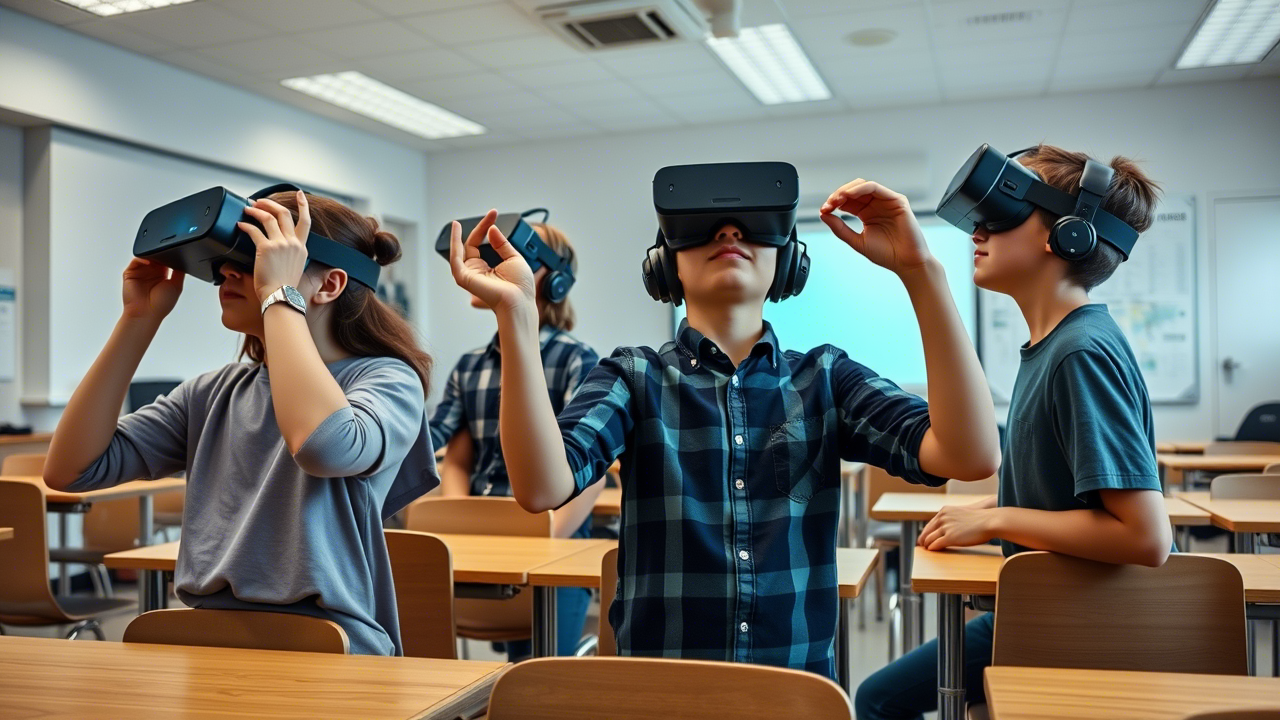Imagine attending a history class where you’re not just reading about ancient Rome — you’re walking through the Colosseum, feeling the echoes of gladiators and hearing the roar of the crowd as if it’s all happening right in front of you. This is the magic of immersive education in the metaverse, where the boundaries of traditional learning dissolve and the classroom stretches into a digital world full of interactive, real-time experiences.
The metaverse, a rapidly evolving digital universe of interconnected virtual spaces, is quickly becoming a game-changer for education, offering endless opportunities to blend the digital and physical in exciting new ways. In this virtual realm, students can step into any subject — whether it’s exploring the depths of the ocean or flying through the cosmos — bringing a level of engagement that textbooks and lectures can’t match.
The metaverse is reshaping how we approach education, offering personalized learning environments that are not only more accessible but also infinitely more engaging. The metaverse is transforming education from something you do to something you experience, offering a new frontier for both students and teachers alike.
What Is the Metaverse and How Does It Relate to Education?
The metaverse is like a digital theme park where the rides are immersive education experiences. It’s a vast, interconnected virtual world powered by technologies like virtual reality (VR), augmented reality (AR), and mixed reality (MR). VR lets you step into fully immersive environments, AR blends digital elements with the real world, and MR combines both, letting you interact with digital objects in physical spaces. Together, these technologies form the metaverse, unlocking exciting possibilities for immersive education.
Virtual worlds within the metaverse offer students hands-on, interactive learning opportunities that go beyond the limits of traditional classrooms. Imagine studying marine biology by exploring a coral reef or learning architecture by virtually walking through famous buildings. These environments create immersive education experiences that make learning far more engaging and memorable than reading about it in a textbook.
Currently, universities are experimenting with virtual campuses, allowing students to attend classes and interact with professors in fully digital spaces. K-12 schools are also embracing immersive education, using VR to create virtual field trips and bring subjects like history and science to life. The metaverse is quickly becoming an exciting new frontier for education, offering personalized, interactive, and fun ways to learn.
Benefits of Immersive Education in the Metaverse
With gamified lessons, adaptive learning paths, and virtual simulations, students are more engaged than ever before. Beyond just being fun, the metaverse also makes education more accessible, allowing anyone, anywhere, to participate in high-quality learning experiences. From hands-on training in medicine and engineering to accessible classrooms for underserved communities, the metaverse is opening new doors for education that are both practical and equitable.
- Enhanced Engagement and Interaction: Gamified learning, interactive simulations, and virtual environments in the metaverse keep students actively engaged and make education feel like an adventure.
- Personalized Learning: The metaverse allows for adaptive learning paths, catering to individual student needs and learning styles, ensuring a more tailored and effective educational experience.
- Accessibility: Students from anywhere in the world can participate in virtual classrooms and immersive education experiences, providing equitable access to education for all.
- Real-World Simulations: Industries like medicine, architecture, and engineering use the metaverse to simulate real-world experiences for practical, hands-on training without risk or expense.
Real-World Applications and Case Studies
Immersive education is already making waves across various levels of learning, from universities to corporate training.
Related: ‘Smart Money’ Returns to Shiba Inu After Dodging 72% Crash
Higher Education
Institutions like the University of Maryland and the University of Oxford are leading the way by offering virtual classrooms and immersive courses. Students can now engage in virtual study spaces where they collaborate with peers across the globe, attend lectures in 3D environments, or explore subjects like archaeology by virtually digging through ancient ruins. This virtual approach not only enhances learning but also broadens access, allowing students to participate in high-quality education from anywhere.
K-12 Education
Immersive education is making complex subjects much more accessible and engaging. Schools are using VR simulations to bring topics like history and biology to life. These interactive experiences make learning fun, memorable, and deeply impactful for young students.
Corporate Training
The metaverse isn’t just for schools — it’s also revolutionizing corporate training. Walmart, for example, has embraced VR to train employees in customer service scenarios, allowing them to practice real-life situations in a risk-free virtual space. Employees can interact with virtual customers, handle complex situations, and gain valuable experience without the pressure of a real-world environment. This type of immersive education ensures employees are better prepared for challenges and more confident in their roles.
Non-Traditional Learners
For non-traditional learners, immersive education is breaking down barriers to continuous learning. Adult education programs are using VR and AR to offer hands-on training for skills ranging from healthcare to business management. These tools allow learners to engage with the material in new ways, making education more flexible and accessible for people looking to upskill or change careers. With immersive technologies, learning no longer has to happen in a traditional classroom — it can take place anywhere, at any time, for anyone.
Challenges and Limitations
While immersive education holds a lot of promise, there are still several challenges that need to be overcome. From technological barriers to issues with scalability and access, it’s clear that we’re not quite there yet. Let’s take a closer look at some of the key obstacles to the widespread adoption of immersive education.
- Technological Barriers: The cost of VR/AR hardware and the need for better connectivity are still significant limitations. High-quality immersive experiences require expensive equipment and strong internet connections, which aren’t available to everyone.
- Scalability Issues: Scaling immersive education to accommodate large numbers of students or institutions is a challenge. Providing VR-based classes or simulations for thousands of students requires a huge amount of resources, both financially and logistically.
- Equity and Access: Not all students have access to the devices or internet needed for immersive education, which can create a digital divide. Students in lower-income areas may be left behind, unable to participate in these transformative learning experiences.
- Teacher Training: To make immersive education effective, educators need specialized training. Without the right tools and knowledge, teachers may struggle to create engaging and impactful virtual learning environments.
The Future of Immersive Education in the Metaverse
The future of immersive education in the metaverse is thrilling. As advancements in AI, 5G, and VR/AR technologies progress, immersive learning will become even more personalized and seamless, allowing for tailored experiences that meet students’ unique needs. Hybrid learning environments will blur the lines between physical classrooms and virtual worlds, offering interactive lessons where students can explore historical sites or conduct experiments from anywhere.
Related: Time Names AI Innovators ‘Architects of AI’ as 2025 Person of the Year
This evolution will also reshape teaching methods and curricula. Educators may adopt more interactive techniques, using virtual environments to enhance learning, while credentials might shift to digital, earned through immersive experiences rather than traditional classroom hours. The future of immersive education is dynamic, flexible, and full of exciting possibilities.
Preparing for the Metaverse: What Educators and Institutions Need to Know How to Get Started
As we look toward integrating immersive education into the classroom, educators and institutions need to take actionable steps to prepare for the metaverse. Here are a few key considerations:
- How to Get Started: Begin by experimenting with accessible VR/AR technologies, integrating them into specific lessons to offer students a glimpse of immersive education.
- Future-Proofing the Curriculum: Adapt curricula to include VR/AR elements, incorporating virtual simulations to bring subjects like history or science to life.
- Collaboration with Tech Providers: Partner with tech companies specializing in immersive education to access the tools and training necessary for teachers to deliver effective lessons in the metaverse.
Conclusion
The metaverse is revolutionizing education, offering immersive experiences that go far beyond traditional methods. From virtual campuses and personalized learning to real-world simulations, the possibilities are endless. While challenges like technology limitations and equity remain, the benefits of immersive education are clear, enhancing engagement and access for all students.
Now is the time for educators, institutions, and policymakers to embrace this technology. By doing so, they can stay ahead of the curve and ensure students are prepared for the future.
As technology continues to evolve, the metaverse will only become more integral to education, transforming the way we teach and learn. The future of education is bright, and the metaverse is at the heart of it.












